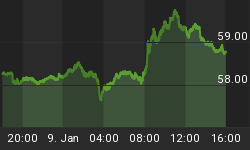The gold sector relative to the S&P500 Index
There have been a number of powerful trends in the financial markets over the past 3 years, one of which is the upward trend in gold stocks relative to the overall stock market. This trend is represented, on the below chart, by the ratio of the AMEX Gold BUGS Index (HUI) and the S&P500 Index.

There are three points we'd like to make with reference to the above chart.
First, although the S&P500's bear market began during the first quarter of 2000 the HUI/S&P500 ratio didn't turn higher until the final quarter of 2000. The reason this happened is that gold stocks (and gold) don't trend in the opposite direction to the US stock market, as many people believe. Rather, they move in the opposite direction to the US$. The US$ generally trends in the same direction as the US stock market, thus creating the appearance that gold stocks are moving higher in response to a falling stock market.
The most bearish environment for gold stocks is actually one where the stock market is falling while the dollar is rising. This is the type of environment that existed between April 2000 and October 2000, a period when gold stocks performed very poorly in both absolute and relative terms. On the other hand, an environment in which the stock market is rising and the dollar is falling is very bullish for gold stocks. This is the type of environment that existed in 1986-1987 and has existed since 21st March of this year (as strong as the US stock market has appeared to have been over the past couple of months, the HUI has been trending higher relative to the S&P500 Index since 21st March).
Not coincidentally the HUI/S&P500 ratio bottomed and embarked on what would turn out to be a major uptrend in November of 2000, within days of the US$ reaching a long-term peak against both the euro and the Swiss Franc.
Second, the HUI/S&P500 ratio is presently very close to its long-term uptrend-line, meaning that the HUI will need to continue to out-perform the S&P500 over the weeks ahead in order to prevent the uptrend from being broken.
As things currently stand the HUI/S&P500 ratio is in a similar position to where it was at the beginning of 2002. If the outcome is the same as it was in early 2002 then the HUI will soon begin to move sharply higher in absolute terms and relative to the S&P500. This is the outcome that appears most likely from both technical and fundamental perspectives. The alternative is that the ratio breaks its long-term uptrend, thus signaling that the bear-market rally in the S&P500 Index that began last October still has a long way to go in terms of both time and price.
Note that an upward acceleration in the HUI/S&P500 ratio over the next few weeks would not necessarily mean that the recovery rally in the S&P500 Index had peaked, but it would strongly suggest that the eventual peak would not be significantly above last Friday's intra-day high.
Third, everything that has happened since the end of May 2002 appears to be a large, extended consolidation within a continuing uptrend. By late-May 2002 the HUI/S&P500 ratio had moved way above its long-term uptrend and it has taken the ratio 12 months to move back to this trend-line.
Gold stocks - current market situation
The below 1-year chart of NEM shows that resistance at $30 has been decisively breached, but that last week's rally halted right at the May-2002 peak. NEM is probably headed well above the May-2002 peak, but a drop back to around $30 (formerly resistance, now support) would not be surprising. In fact, the stock price could retreat all the way back to its intermediate-term uptrend-line (currently around $25.50) without doing significant technical damage to the longer-term bullish case.

The HUI is currently within about 6% of a new 6-year high and, as discussed above, has out-performed the overall stock market since 21st March of this year. The S&P500, on the other hand, is clearly still mired within a primary bear trend. However, based on the current lack of enthusiasm towards the gold sector and the incredible excitement generated by the stock market's recent gains you'd think the opposite was true, that is, you'd think the S&P500 was readying itself for a move to a new 6-year high while gold stocks were experiencing nothing more significant than a strong rebound within an on-going bear market.
The HUI may or may not be ready to break to new multi-year highs in the short-term, but we think that a break to new highs over the next several months is inevitable. And once a breakout does occur the HUI will be on its way to the 200-250 range.
















